Management Practices Evolution Before and After Industry
VerifiedAdded on 2023/01/13
|8
|2323
|66
Essay
AI Summary
This essay provides a comprehensive overview of the evolution of management practices, tracing their development from the pre-industrial revolution era to the post-industrial period. It examines how management approaches shifted from labor-intensive techniques and centralized decision-making to more scientific and human-resource-focused strategies. The essay highlights the impact of industrialization on management practices, including the adoption of new technologies and the importance of strategic planning. Furthermore, it explores the growth of management practices in the post-industrial era, emphasizing the shift towards participatory methods, technological integration, and the importance of adapting to market changes. The essay concludes by underscoring the continuous evolution of management practices in response to dynamic environments and the need for innovation to achieve sustainable development and competitive advantage.

MANAGEMENT
Paraphrase This Document
Need a fresh take? Get an instant paraphrase of this document with our AI Paraphraser
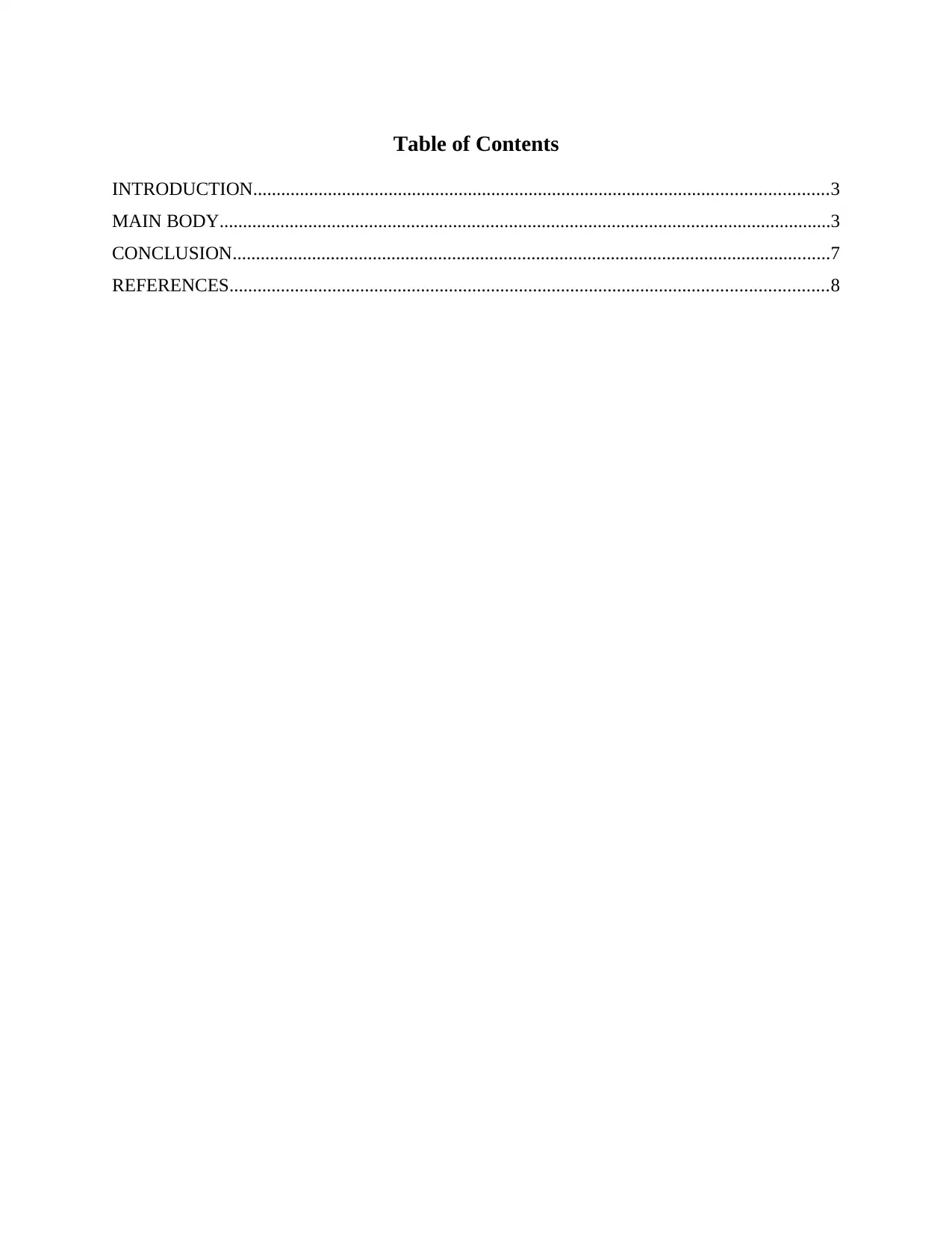
Table of Contents
INTRODUCTION...........................................................................................................................3
MAIN BODY...................................................................................................................................3
CONCLUSION................................................................................................................................7
REFERENCES................................................................................................................................8
INTRODUCTION...........................................................................................................................3
MAIN BODY...................................................................................................................................3
CONCLUSION................................................................................................................................7
REFERENCES................................................................................................................................8
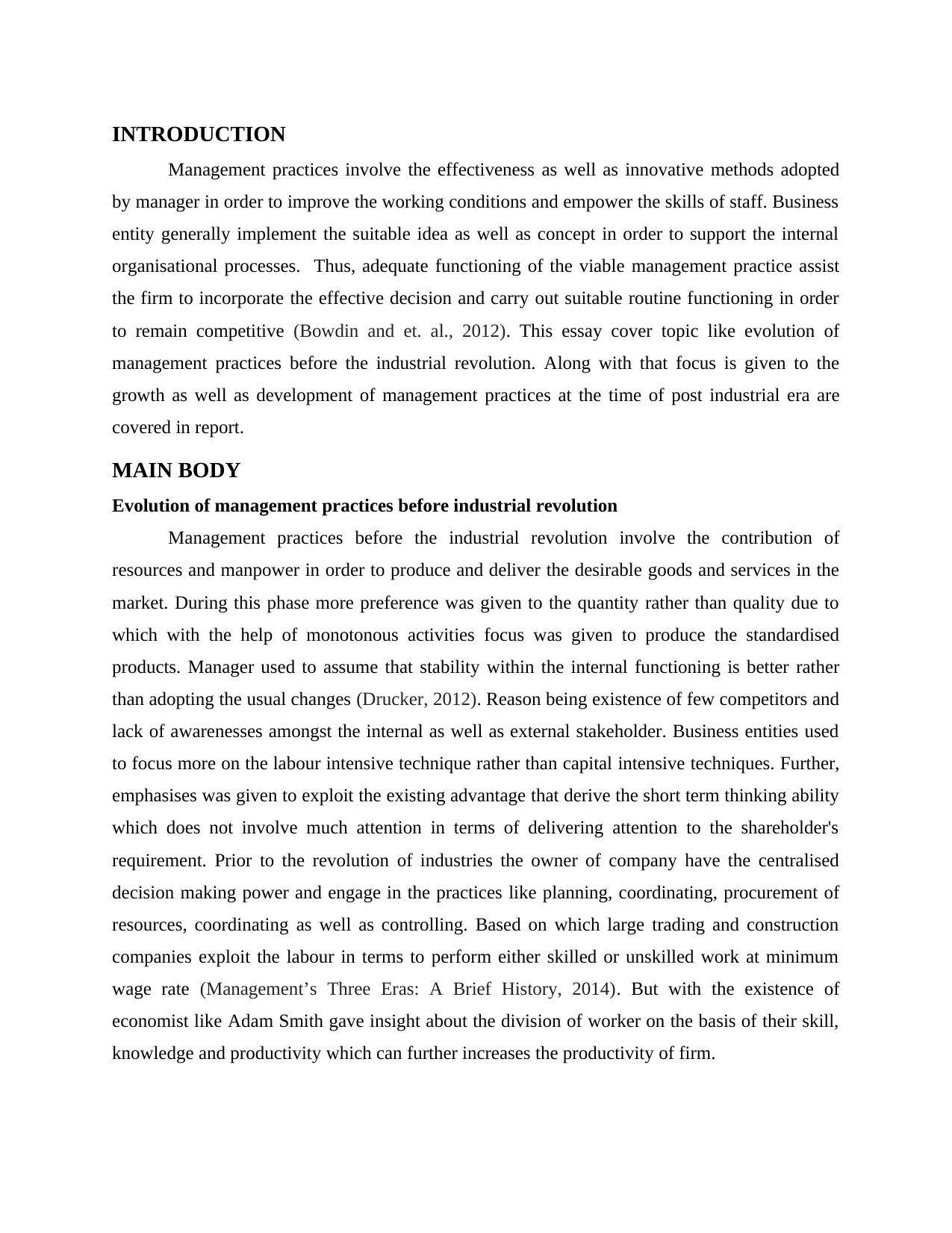
INTRODUCTION
Management practices involve the effectiveness as well as innovative methods adopted
by manager in order to improve the working conditions and empower the skills of staff. Business
entity generally implement the suitable idea as well as concept in order to support the internal
organisational processes. Thus, adequate functioning of the viable management practice assist
the firm to incorporate the effective decision and carry out suitable routine functioning in order
to remain competitive (Bowdin and et. al., 2012). This essay cover topic like evolution of
management practices before the industrial revolution. Along with that focus is given to the
growth as well as development of management practices at the time of post industrial era are
covered in report.
MAIN BODY
Evolution of management practices before industrial revolution
Management practices before the industrial revolution involve the contribution of
resources and manpower in order to produce and deliver the desirable goods and services in the
market. During this phase more preference was given to the quantity rather than quality due to
which with the help of monotonous activities focus was given to produce the standardised
products. Manager used to assume that stability within the internal functioning is better rather
than adopting the usual changes (Drucker, 2012). Reason being existence of few competitors and
lack of awarenesses amongst the internal as well as external stakeholder. Business entities used
to focus more on the labour intensive technique rather than capital intensive techniques. Further,
emphasises was given to exploit the existing advantage that derive the short term thinking ability
which does not involve much attention in terms of delivering attention to the shareholder's
requirement. Prior to the revolution of industries the owner of company have the centralised
decision making power and engage in the practices like planning, coordinating, procurement of
resources, coordinating as well as controlling. Based on which large trading and construction
companies exploit the labour in terms to perform either skilled or unskilled work at minimum
wage rate (Management’s Three Eras: A Brief History, 2014). But with the existence of
economist like Adam Smith gave insight about the division of worker on the basis of their skill,
knowledge and productivity which can further increases the productivity of firm.
Management practices involve the effectiveness as well as innovative methods adopted
by manager in order to improve the working conditions and empower the skills of staff. Business
entity generally implement the suitable idea as well as concept in order to support the internal
organisational processes. Thus, adequate functioning of the viable management practice assist
the firm to incorporate the effective decision and carry out suitable routine functioning in order
to remain competitive (Bowdin and et. al., 2012). This essay cover topic like evolution of
management practices before the industrial revolution. Along with that focus is given to the
growth as well as development of management practices at the time of post industrial era are
covered in report.
MAIN BODY
Evolution of management practices before industrial revolution
Management practices before the industrial revolution involve the contribution of
resources and manpower in order to produce and deliver the desirable goods and services in the
market. During this phase more preference was given to the quantity rather than quality due to
which with the help of monotonous activities focus was given to produce the standardised
products. Manager used to assume that stability within the internal functioning is better rather
than adopting the usual changes (Drucker, 2012). Reason being existence of few competitors and
lack of awarenesses amongst the internal as well as external stakeholder. Business entities used
to focus more on the labour intensive technique rather than capital intensive techniques. Further,
emphasises was given to exploit the existing advantage that derive the short term thinking ability
which does not involve much attention in terms of delivering attention to the shareholder's
requirement. Prior to the revolution of industries the owner of company have the centralised
decision making power and engage in the practices like planning, coordinating, procurement of
resources, coordinating as well as controlling. Based on which large trading and construction
companies exploit the labour in terms to perform either skilled or unskilled work at minimum
wage rate (Management’s Three Eras: A Brief History, 2014). But with the existence of
economist like Adam Smith gave insight about the division of worker on the basis of their skill,
knowledge and productivity which can further increases the productivity of firm.
⊘ This is a preview!⊘
Do you want full access?
Subscribe today to unlock all pages.

Trusted by 1+ million students worldwide
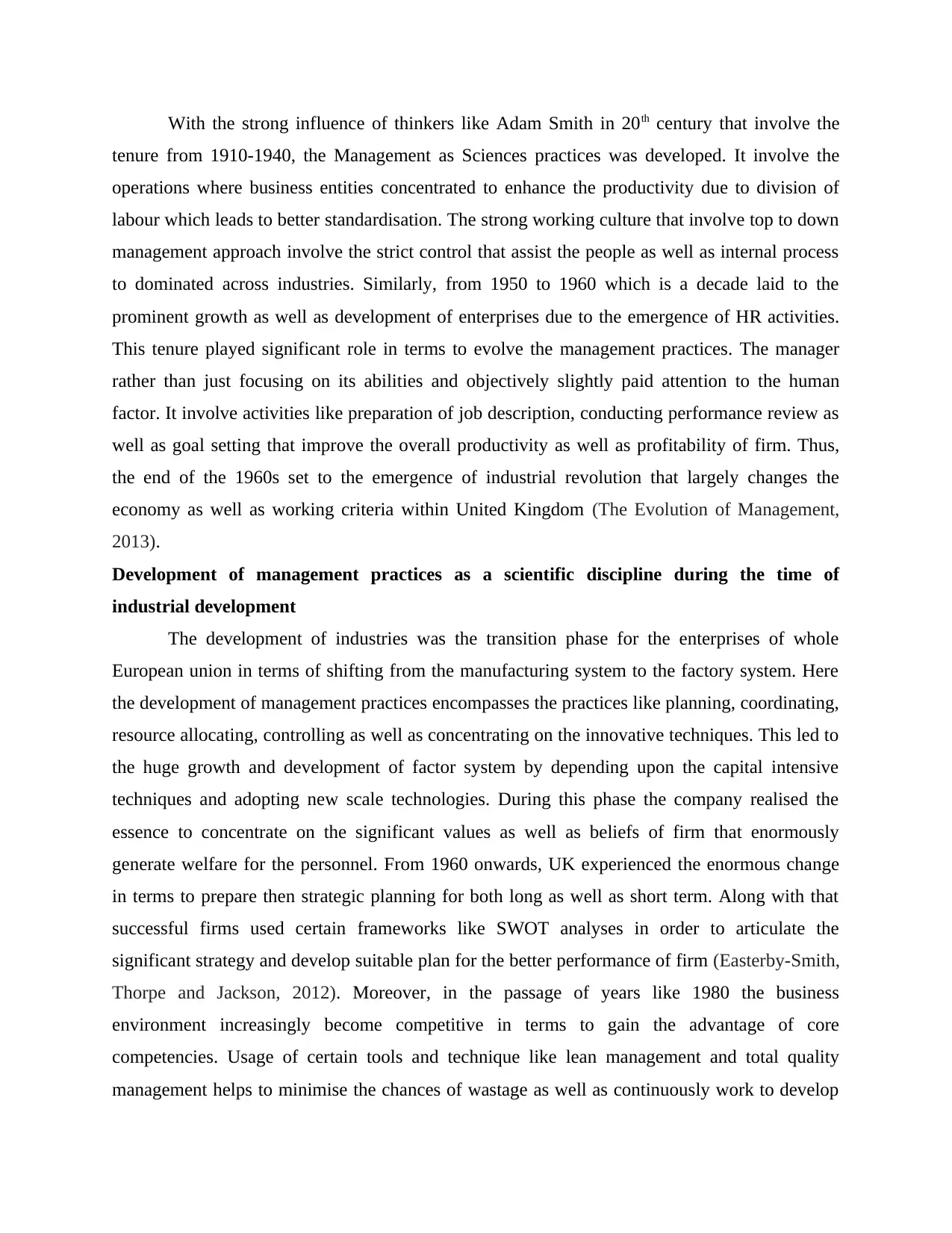
With the strong influence of thinkers like Adam Smith in 20th century that involve the
tenure from 1910-1940, the Management as Sciences practices was developed. It involve the
operations where business entities concentrated to enhance the productivity due to division of
labour which leads to better standardisation. The strong working culture that involve top to down
management approach involve the strict control that assist the people as well as internal process
to dominated across industries. Similarly, from 1950 to 1960 which is a decade laid to the
prominent growth as well as development of enterprises due to the emergence of HR activities.
This tenure played significant role in terms to evolve the management practices. The manager
rather than just focusing on its abilities and objectively slightly paid attention to the human
factor. It involve activities like preparation of job description, conducting performance review as
well as goal setting that improve the overall productivity as well as profitability of firm. Thus,
the end of the 1960s set to the emergence of industrial revolution that largely changes the
economy as well as working criteria within United Kingdom (The Evolution of Management,
2013).
Development of management practices as a scientific discipline during the time of
industrial development
The development of industries was the transition phase for the enterprises of whole
European union in terms of shifting from the manufacturing system to the factory system. Here
the development of management practices encompasses the practices like planning, coordinating,
resource allocating, controlling as well as concentrating on the innovative techniques. This led to
the huge growth and development of factor system by depending upon the capital intensive
techniques and adopting new scale technologies. During this phase the company realised the
essence to concentrate on the significant values as well as beliefs of firm that enormously
generate welfare for the personnel. From 1960 onwards, UK experienced the enormous change
in terms to prepare then strategic planning for both long as well as short term. Along with that
successful firms used certain frameworks like SWOT analyses in order to articulate the
significant strategy and develop suitable plan for the better performance of firm (Easterby-Smith,
Thorpe and Jackson, 2012). Moreover, in the passage of years like 1980 the business
environment increasingly become competitive in terms to gain the advantage of core
competencies. Usage of certain tools and technique like lean management and total quality
management helps to minimise the chances of wastage as well as continuously work to develop
tenure from 1910-1940, the Management as Sciences practices was developed. It involve the
operations where business entities concentrated to enhance the productivity due to division of
labour which leads to better standardisation. The strong working culture that involve top to down
management approach involve the strict control that assist the people as well as internal process
to dominated across industries. Similarly, from 1950 to 1960 which is a decade laid to the
prominent growth as well as development of enterprises due to the emergence of HR activities.
This tenure played significant role in terms to evolve the management practices. The manager
rather than just focusing on its abilities and objectively slightly paid attention to the human
factor. It involve activities like preparation of job description, conducting performance review as
well as goal setting that improve the overall productivity as well as profitability of firm. Thus,
the end of the 1960s set to the emergence of industrial revolution that largely changes the
economy as well as working criteria within United Kingdom (The Evolution of Management,
2013).
Development of management practices as a scientific discipline during the time of
industrial development
The development of industries was the transition phase for the enterprises of whole
European union in terms of shifting from the manufacturing system to the factory system. Here
the development of management practices encompasses the practices like planning, coordinating,
resource allocating, controlling as well as concentrating on the innovative techniques. This led to
the huge growth and development of factor system by depending upon the capital intensive
techniques and adopting new scale technologies. During this phase the company realised the
essence to concentrate on the significant values as well as beliefs of firm that enormously
generate welfare for the personnel. From 1960 onwards, UK experienced the enormous change
in terms to prepare then strategic planning for both long as well as short term. Along with that
successful firms used certain frameworks like SWOT analyses in order to articulate the
significant strategy and develop suitable plan for the better performance of firm (Easterby-Smith,
Thorpe and Jackson, 2012). Moreover, in the passage of years like 1980 the business
environment increasingly become competitive in terms to gain the advantage of core
competencies. Usage of certain tools and technique like lean management and total quality
management helps to minimise the chances of wastage as well as continuously work to develop
Paraphrase This Document
Need a fresh take? Get an instant paraphrase of this document with our AI Paraphraser
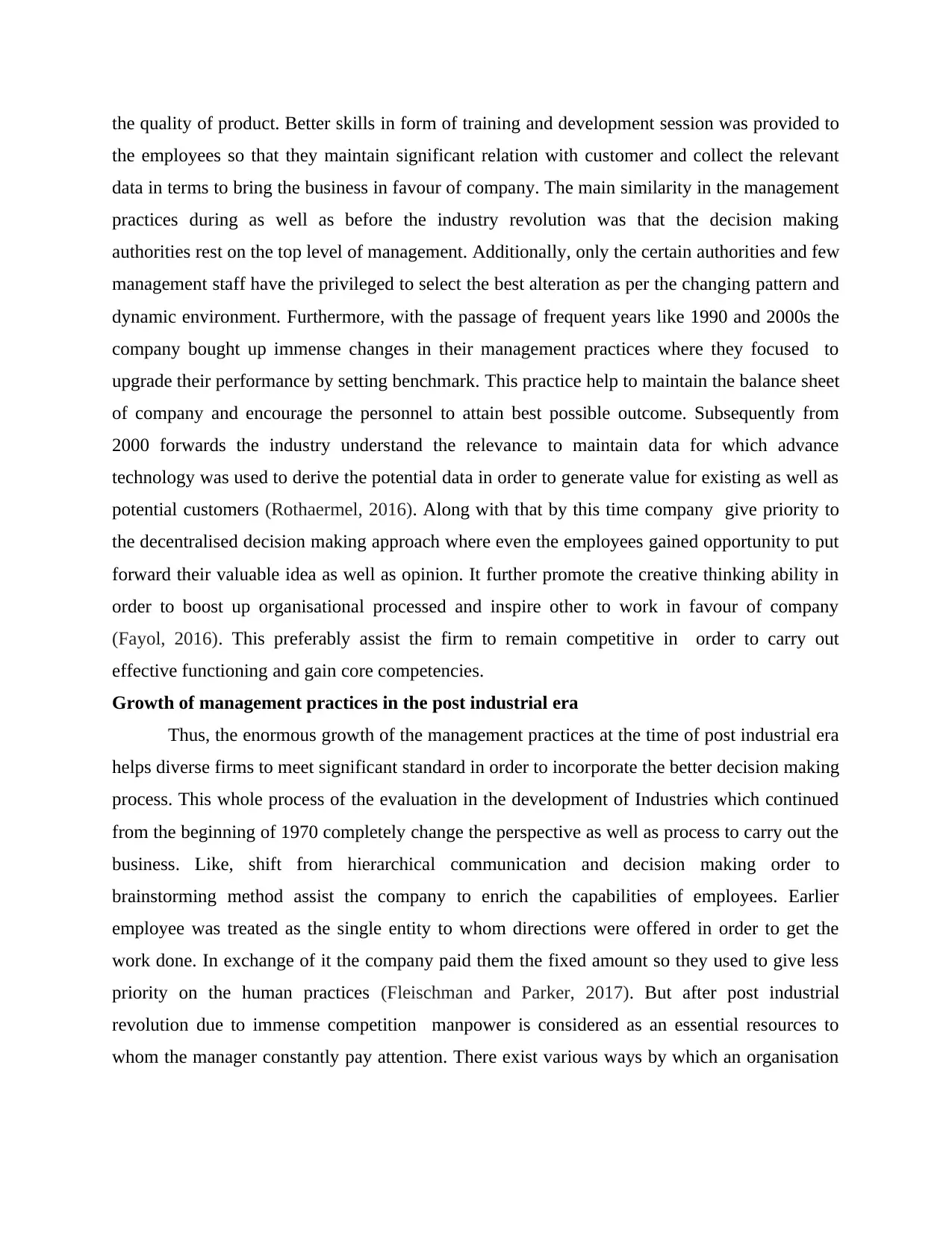
the quality of product. Better skills in form of training and development session was provided to
the employees so that they maintain significant relation with customer and collect the relevant
data in terms to bring the business in favour of company. The main similarity in the management
practices during as well as before the industry revolution was that the decision making
authorities rest on the top level of management. Additionally, only the certain authorities and few
management staff have the privileged to select the best alteration as per the changing pattern and
dynamic environment. Furthermore, with the passage of frequent years like 1990 and 2000s the
company bought up immense changes in their management practices where they focused to
upgrade their performance by setting benchmark. This practice help to maintain the balance sheet
of company and encourage the personnel to attain best possible outcome. Subsequently from
2000 forwards the industry understand the relevance to maintain data for which advance
technology was used to derive the potential data in order to generate value for existing as well as
potential customers (Rothaermel, 2016). Along with that by this time company give priority to
the decentralised decision making approach where even the employees gained opportunity to put
forward their valuable idea as well as opinion. It further promote the creative thinking ability in
order to boost up organisational processed and inspire other to work in favour of company
(Fayol, 2016). This preferably assist the firm to remain competitive in order to carry out
effective functioning and gain core competencies.
Growth of management practices in the post industrial era
Thus, the enormous growth of the management practices at the time of post industrial era
helps diverse firms to meet significant standard in order to incorporate the better decision making
process. This whole process of the evaluation in the development of Industries which continued
from the beginning of 1970 completely change the perspective as well as process to carry out the
business. Like, shift from hierarchical communication and decision making order to
brainstorming method assist the company to enrich the capabilities of employees. Earlier
employee was treated as the single entity to whom directions were offered in order to get the
work done. In exchange of it the company paid them the fixed amount so they used to give less
priority on the human practices (Fleischman and Parker, 2017). But after post industrial
revolution due to immense competition manpower is considered as an essential resources to
whom the manager constantly pay attention. There exist various ways by which an organisation
the employees so that they maintain significant relation with customer and collect the relevant
data in terms to bring the business in favour of company. The main similarity in the management
practices during as well as before the industry revolution was that the decision making
authorities rest on the top level of management. Additionally, only the certain authorities and few
management staff have the privileged to select the best alteration as per the changing pattern and
dynamic environment. Furthermore, with the passage of frequent years like 1990 and 2000s the
company bought up immense changes in their management practices where they focused to
upgrade their performance by setting benchmark. This practice help to maintain the balance sheet
of company and encourage the personnel to attain best possible outcome. Subsequently from
2000 forwards the industry understand the relevance to maintain data for which advance
technology was used to derive the potential data in order to generate value for existing as well as
potential customers (Rothaermel, 2016). Along with that by this time company give priority to
the decentralised decision making approach where even the employees gained opportunity to put
forward their valuable idea as well as opinion. It further promote the creative thinking ability in
order to boost up organisational processed and inspire other to work in favour of company
(Fayol, 2016). This preferably assist the firm to remain competitive in order to carry out
effective functioning and gain core competencies.
Growth of management practices in the post industrial era
Thus, the enormous growth of the management practices at the time of post industrial era
helps diverse firms to meet significant standard in order to incorporate the better decision making
process. This whole process of the evaluation in the development of Industries which continued
from the beginning of 1970 completely change the perspective as well as process to carry out the
business. Like, shift from hierarchical communication and decision making order to
brainstorming method assist the company to enrich the capabilities of employees. Earlier
employee was treated as the single entity to whom directions were offered in order to get the
work done. In exchange of it the company paid them the fixed amount so they used to give less
priority on the human practices (Fleischman and Parker, 2017). But after post industrial
revolution due to immense competition manpower is considered as an essential resources to
whom the manager constantly pay attention. There exist various ways by which an organisation
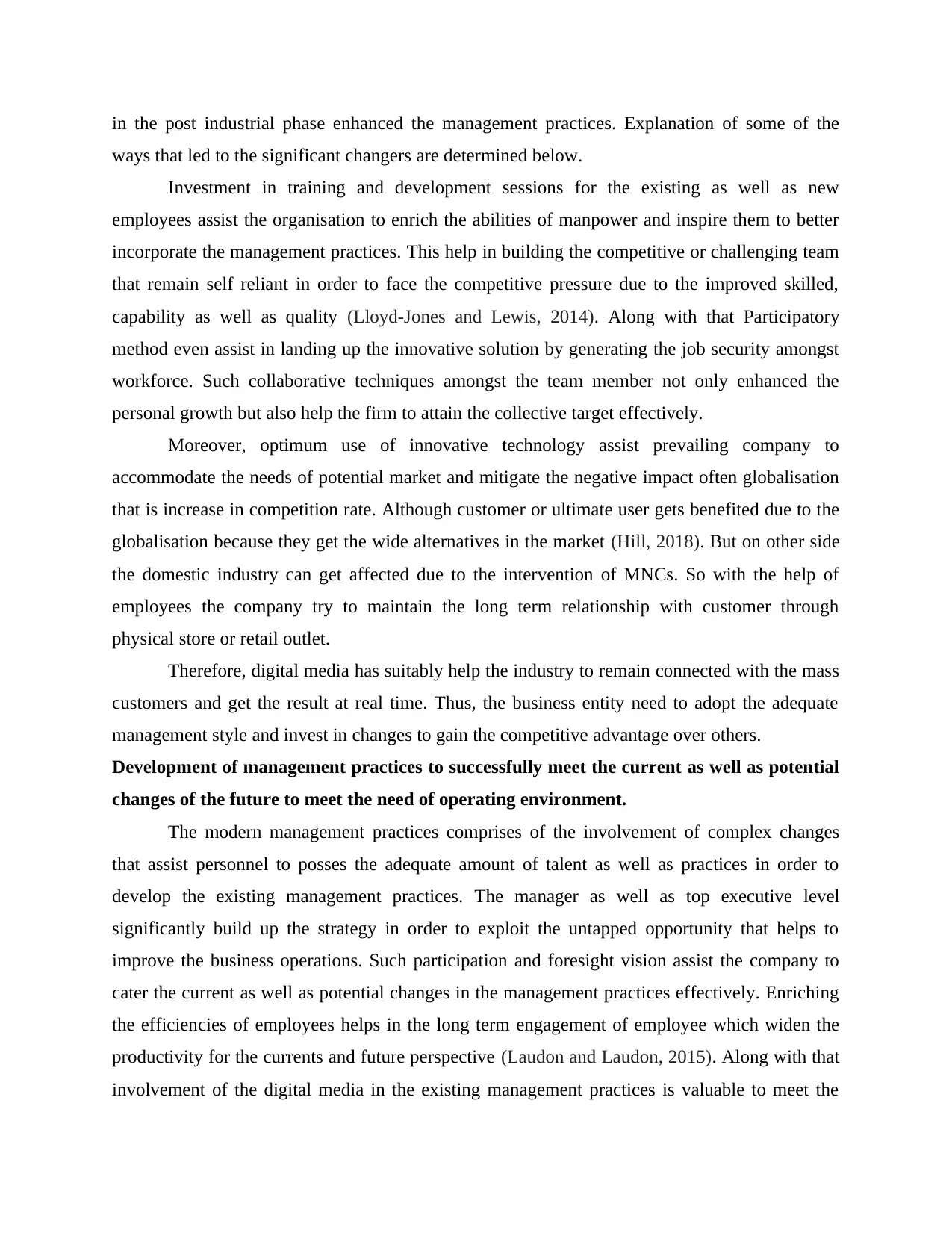
in the post industrial phase enhanced the management practices. Explanation of some of the
ways that led to the significant changers are determined below.
Investment in training and development sessions for the existing as well as new
employees assist the organisation to enrich the abilities of manpower and inspire them to better
incorporate the management practices. This help in building the competitive or challenging team
that remain self reliant in order to face the competitive pressure due to the improved skilled,
capability as well as quality (Lloyd-Jones and Lewis, 2014). Along with that Participatory
method even assist in landing up the innovative solution by generating the job security amongst
workforce. Such collaborative techniques amongst the team member not only enhanced the
personal growth but also help the firm to attain the collective target effectively.
Moreover, optimum use of innovative technology assist prevailing company to
accommodate the needs of potential market and mitigate the negative impact often globalisation
that is increase in competition rate. Although customer or ultimate user gets benefited due to the
globalisation because they get the wide alternatives in the market (Hill, 2018). But on other side
the domestic industry can get affected due to the intervention of MNCs. So with the help of
employees the company try to maintain the long term relationship with customer through
physical store or retail outlet.
Therefore, digital media has suitably help the industry to remain connected with the mass
customers and get the result at real time. Thus, the business entity need to adopt the adequate
management style and invest in changes to gain the competitive advantage over others.
Development of management practices to successfully meet the current as well as potential
changes of the future to meet the need of operating environment.
The modern management practices comprises of the involvement of complex changes
that assist personnel to posses the adequate amount of talent as well as practices in order to
develop the existing management practices. The manager as well as top executive level
significantly build up the strategy in order to exploit the untapped opportunity that helps to
improve the business operations. Such participation and foresight vision assist the company to
cater the current as well as potential changes in the management practices effectively. Enriching
the efficiencies of employees helps in the long term engagement of employee which widen the
productivity for the currents and future perspective (Laudon and Laudon, 2015). Along with that
involvement of the digital media in the existing management practices is valuable to meet the
ways that led to the significant changers are determined below.
Investment in training and development sessions for the existing as well as new
employees assist the organisation to enrich the abilities of manpower and inspire them to better
incorporate the management practices. This help in building the competitive or challenging team
that remain self reliant in order to face the competitive pressure due to the improved skilled,
capability as well as quality (Lloyd-Jones and Lewis, 2014). Along with that Participatory
method even assist in landing up the innovative solution by generating the job security amongst
workforce. Such collaborative techniques amongst the team member not only enhanced the
personal growth but also help the firm to attain the collective target effectively.
Moreover, optimum use of innovative technology assist prevailing company to
accommodate the needs of potential market and mitigate the negative impact often globalisation
that is increase in competition rate. Although customer or ultimate user gets benefited due to the
globalisation because they get the wide alternatives in the market (Hill, 2018). But on other side
the domestic industry can get affected due to the intervention of MNCs. So with the help of
employees the company try to maintain the long term relationship with customer through
physical store or retail outlet.
Therefore, digital media has suitably help the industry to remain connected with the mass
customers and get the result at real time. Thus, the business entity need to adopt the adequate
management style and invest in changes to gain the competitive advantage over others.
Development of management practices to successfully meet the current as well as potential
changes of the future to meet the need of operating environment.
The modern management practices comprises of the involvement of complex changes
that assist personnel to posses the adequate amount of talent as well as practices in order to
develop the existing management practices. The manager as well as top executive level
significantly build up the strategy in order to exploit the untapped opportunity that helps to
improve the business operations. Such participation and foresight vision assist the company to
cater the current as well as potential changes in the management practices effectively. Enriching
the efficiencies of employees helps in the long term engagement of employee which widen the
productivity for the currents and future perspective (Laudon and Laudon, 2015). Along with that
involvement of the digital media in the existing management practices is valuable to meet the
⊘ This is a preview!⊘
Do you want full access?
Subscribe today to unlock all pages.

Trusted by 1+ million students worldwide
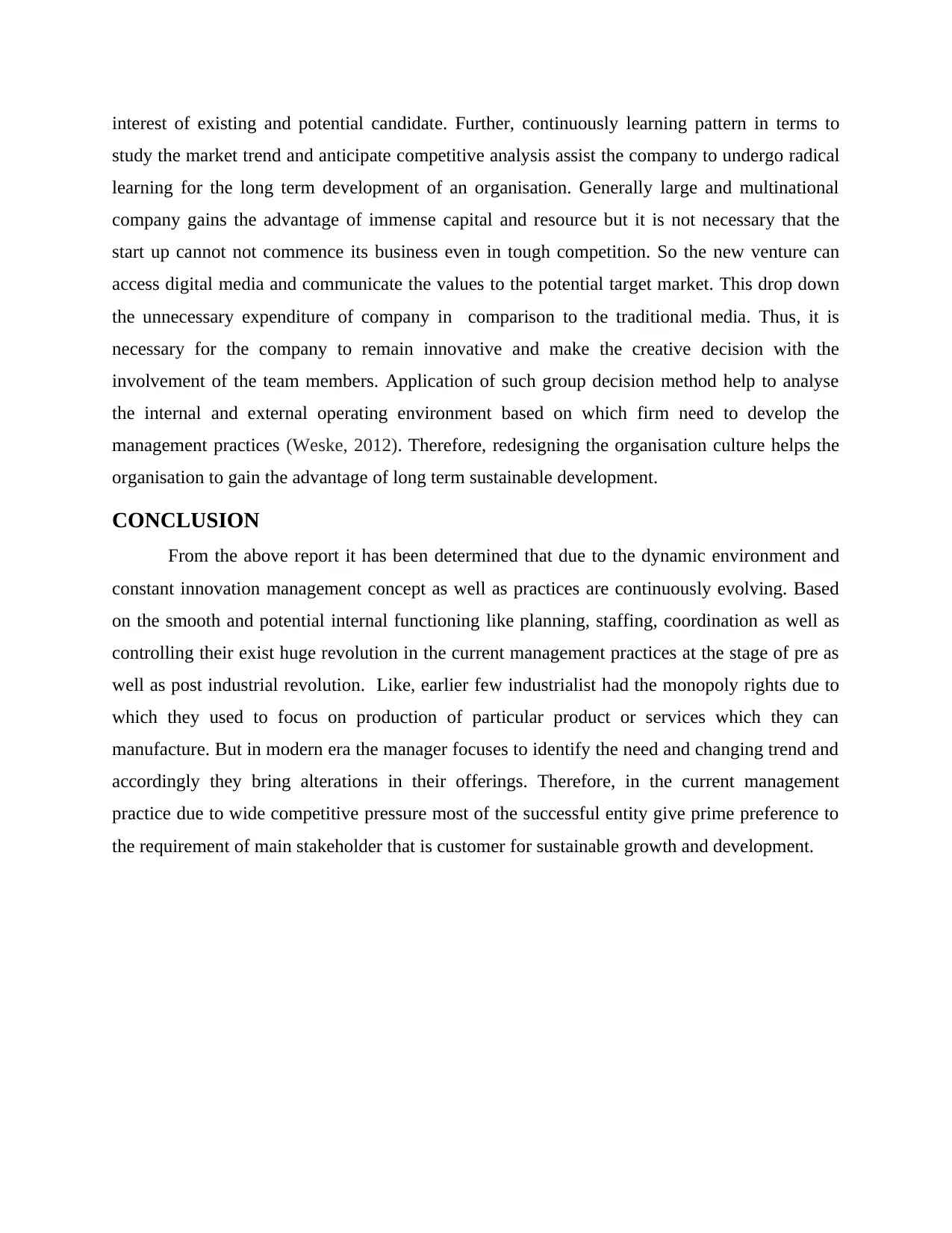
interest of existing and potential candidate. Further, continuously learning pattern in terms to
study the market trend and anticipate competitive analysis assist the company to undergo radical
learning for the long term development of an organisation. Generally large and multinational
company gains the advantage of immense capital and resource but it is not necessary that the
start up cannot not commence its business even in tough competition. So the new venture can
access digital media and communicate the values to the potential target market. This drop down
the unnecessary expenditure of company in comparison to the traditional media. Thus, it is
necessary for the company to remain innovative and make the creative decision with the
involvement of the team members. Application of such group decision method help to analyse
the internal and external operating environment based on which firm need to develop the
management practices (Weske, 2012). Therefore, redesigning the organisation culture helps the
organisation to gain the advantage of long term sustainable development.
CONCLUSION
From the above report it has been determined that due to the dynamic environment and
constant innovation management concept as well as practices are continuously evolving. Based
on the smooth and potential internal functioning like planning, staffing, coordination as well as
controlling their exist huge revolution in the current management practices at the stage of pre as
well as post industrial revolution. Like, earlier few industrialist had the monopoly rights due to
which they used to focus on production of particular product or services which they can
manufacture. But in modern era the manager focuses to identify the need and changing trend and
accordingly they bring alterations in their offerings. Therefore, in the current management
practice due to wide competitive pressure most of the successful entity give prime preference to
the requirement of main stakeholder that is customer for sustainable growth and development.
study the market trend and anticipate competitive analysis assist the company to undergo radical
learning for the long term development of an organisation. Generally large and multinational
company gains the advantage of immense capital and resource but it is not necessary that the
start up cannot not commence its business even in tough competition. So the new venture can
access digital media and communicate the values to the potential target market. This drop down
the unnecessary expenditure of company in comparison to the traditional media. Thus, it is
necessary for the company to remain innovative and make the creative decision with the
involvement of the team members. Application of such group decision method help to analyse
the internal and external operating environment based on which firm need to develop the
management practices (Weske, 2012). Therefore, redesigning the organisation culture helps the
organisation to gain the advantage of long term sustainable development.
CONCLUSION
From the above report it has been determined that due to the dynamic environment and
constant innovation management concept as well as practices are continuously evolving. Based
on the smooth and potential internal functioning like planning, staffing, coordination as well as
controlling their exist huge revolution in the current management practices at the stage of pre as
well as post industrial revolution. Like, earlier few industrialist had the monopoly rights due to
which they used to focus on production of particular product or services which they can
manufacture. But in modern era the manager focuses to identify the need and changing trend and
accordingly they bring alterations in their offerings. Therefore, in the current management
practice due to wide competitive pressure most of the successful entity give prime preference to
the requirement of main stakeholder that is customer for sustainable growth and development.
Paraphrase This Document
Need a fresh take? Get an instant paraphrase of this document with our AI Paraphraser
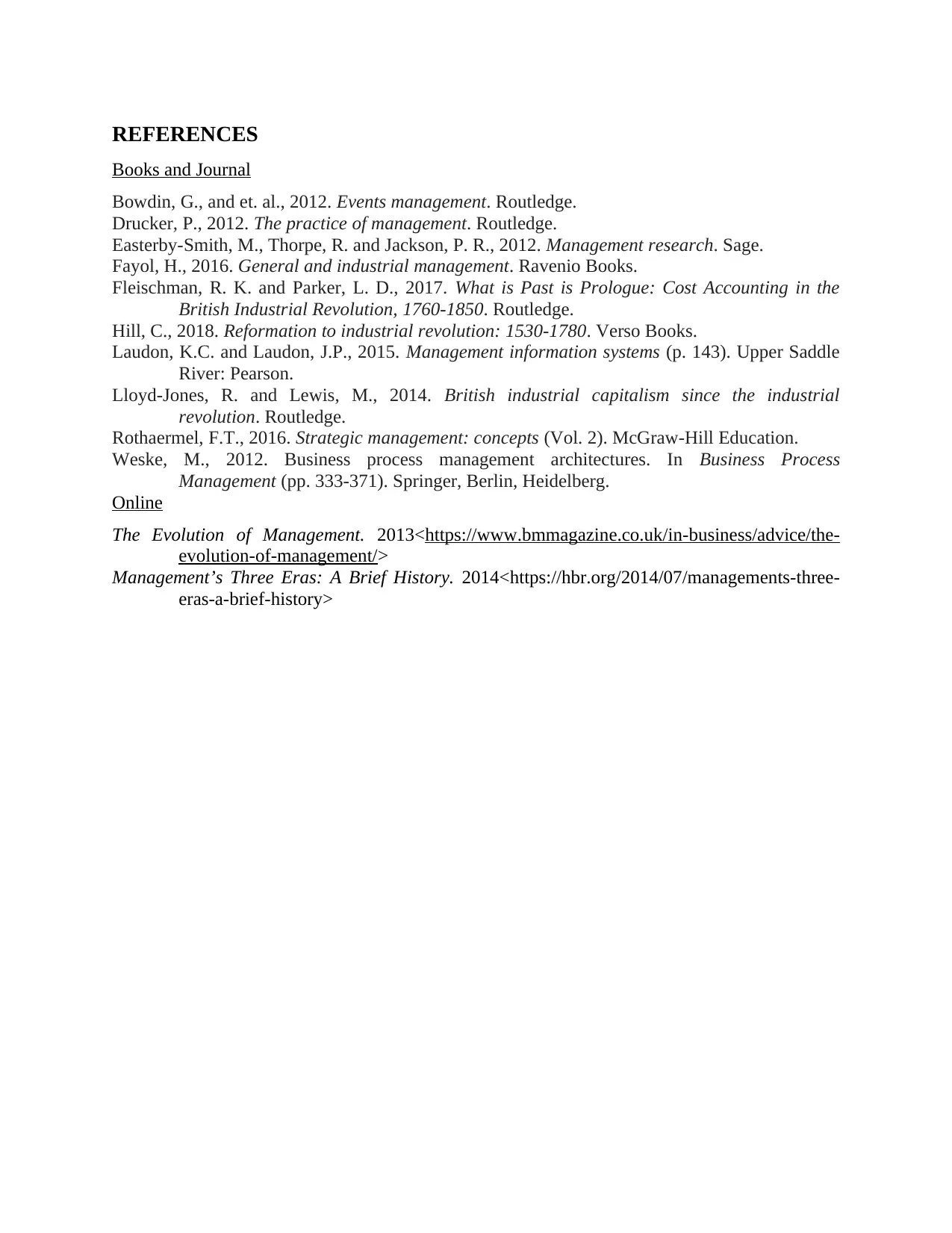
REFERENCES
Books and Journal
Bowdin, G., and et. al., 2012. Events management. Routledge.
Drucker, P., 2012. The practice of management. Routledge.
Easterby-Smith, M., Thorpe, R. and Jackson, P. R., 2012. Management research. Sage.
Fayol, H., 2016. General and industrial management. Ravenio Books.
Fleischman, R. K. and Parker, L. D., 2017. What is Past is Prologue: Cost Accounting in the
British Industrial Revolution, 1760-1850. Routledge.
Hill, C., 2018. Reformation to industrial revolution: 1530-1780. Verso Books.
Laudon, K.C. and Laudon, J.P., 2015. Management information systems (p. 143). Upper Saddle
River: Pearson.
Lloyd-Jones, R. and Lewis, M., 2014. British industrial capitalism since the industrial
revolution. Routledge.
Rothaermel, F.T., 2016. Strategic management: concepts (Vol. 2). McGraw-Hill Education.
Weske, M., 2012. Business process management architectures. In Business Process
Management (pp. 333-371). Springer, Berlin, Heidelberg.
Online
The Evolution of Management. 2013<https://www.bmmagazine.co.uk/in-business/advice/the-
evolution-of-management/>
Management’s Three Eras: A Brief History. 2014<https://hbr.org/2014/07/managements-three-
eras-a-brief-history>
Books and Journal
Bowdin, G., and et. al., 2012. Events management. Routledge.
Drucker, P., 2012. The practice of management. Routledge.
Easterby-Smith, M., Thorpe, R. and Jackson, P. R., 2012. Management research. Sage.
Fayol, H., 2016. General and industrial management. Ravenio Books.
Fleischman, R. K. and Parker, L. D., 2017. What is Past is Prologue: Cost Accounting in the
British Industrial Revolution, 1760-1850. Routledge.
Hill, C., 2018. Reformation to industrial revolution: 1530-1780. Verso Books.
Laudon, K.C. and Laudon, J.P., 2015. Management information systems (p. 143). Upper Saddle
River: Pearson.
Lloyd-Jones, R. and Lewis, M., 2014. British industrial capitalism since the industrial
revolution. Routledge.
Rothaermel, F.T., 2016. Strategic management: concepts (Vol. 2). McGraw-Hill Education.
Weske, M., 2012. Business process management architectures. In Business Process
Management (pp. 333-371). Springer, Berlin, Heidelberg.
Online
The Evolution of Management. 2013<https://www.bmmagazine.co.uk/in-business/advice/the-
evolution-of-management/>
Management’s Three Eras: A Brief History. 2014<https://hbr.org/2014/07/managements-three-
eras-a-brief-history>
1 out of 8
Related Documents
Your All-in-One AI-Powered Toolkit for Academic Success.
+13062052269
info@desklib.com
Available 24*7 on WhatsApp / Email
![[object Object]](/_next/static/media/star-bottom.7253800d.svg)
Unlock your academic potential
Copyright © 2020–2025 A2Z Services. All Rights Reserved. Developed and managed by ZUCOL.





